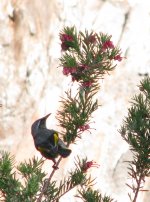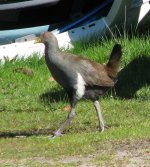chowchilla
Well-known member
Tassie is somewhere I had been meaning to go for some time now. It was a small apple-shaped island off the south coast of Australia, quite different from the mainland or so I'd been told. Rather more importantly, from a birding perspective it had no less than 12 endemic species found nowhere else. There were also several other local specialities that I was hoping to connect with and seeing these birds was the primary purpose of this trip; though it was also an exploratory visit to look at the feasibliity of moving there in the future.
I live in the tropics. It's warm or hot here throughout the year. It goes without saying that Tassie is 'rather cooler', especially in late winter, the time of my visit. I planned to fly in on the 18th September 2014 and back to Cairns on the 24th, so I had six days in which to make good my intentions to get the local endemics.
FTR I don't drive and was severely limited to where I could visit. This would ultimately prove costly as you will see... I also completely stuffed my ankles and my right knee on the first day, making it difficult to even walk on level ground. I decided to base myself in Hobart and make the most of what public transport accessibility I had from there. I stayed in the Grosvenor Court Apartments in Sandy Bay for just over $100 a night. I hardly slept a wink the whole time I was there due to paper thin walls and the fact that I am so used to the white noise of fans or aircon that I just don't sleep without it anymore. However the apartments were very nicely appointed and the staff friendly and helpful.
I will keep a running tally of new birds seen for the duration of the trip with lifers in bold.
Thus it was that my plane landed in the early afternoon of the 18th after nine hours in transit from Cairns (mostly taken up by a ridiculously long transfer in Sydney). As we taxied off the runway, I could see two Forest Ravens rummaging around in the short airport turf; my first lifer of the trip. FTR Forest Ravens are the only Corvid found on Tassie, so no ID nightmares as on the mainland between five virtually identical species. It was also the only Aussie corvid I hadn't seen to date. As I waited for the airport bus to turn up, I clocked a number of European Starlings in the vicinity. Then I heard a Lorikeet in a nearby flowering tree which could only be one species. After a minute or so of searching, I eventually spotted a lone Musk Lorikeet in the top of the tree. A few Silver Gulls were also around.
En route to the apartments I added Masked Lapwing which proved to be common everywhere as they are in and around Cairns. As we drove through the centre of Hobart, I clocked several Kelp Gulls flying around the buildings amongst the Silver Gulls. This is a recent colonist from NZ and only the second time I'd seen them.
I was so exhausted having been up two days that I went to bed mid-afternoon. Approximately 10 hours later, I finally fell asleep due to the eventual cessation of the relentless noise of a large group of gymnasts staying in the apartments. I kid you not.
Forest Raven.
European Starling.
Musk Lorikeet.
Silver Gull.
Masked Lapwing.
Kelp Gull.
I live in the tropics. It's warm or hot here throughout the year. It goes without saying that Tassie is 'rather cooler', especially in late winter, the time of my visit. I planned to fly in on the 18th September 2014 and back to Cairns on the 24th, so I had six days in which to make good my intentions to get the local endemics.
FTR I don't drive and was severely limited to where I could visit. This would ultimately prove costly as you will see... I also completely stuffed my ankles and my right knee on the first day, making it difficult to even walk on level ground. I decided to base myself in Hobart and make the most of what public transport accessibility I had from there. I stayed in the Grosvenor Court Apartments in Sandy Bay for just over $100 a night. I hardly slept a wink the whole time I was there due to paper thin walls and the fact that I am so used to the white noise of fans or aircon that I just don't sleep without it anymore. However the apartments were very nicely appointed and the staff friendly and helpful.
I will keep a running tally of new birds seen for the duration of the trip with lifers in bold.
Thus it was that my plane landed in the early afternoon of the 18th after nine hours in transit from Cairns (mostly taken up by a ridiculously long transfer in Sydney). As we taxied off the runway, I could see two Forest Ravens rummaging around in the short airport turf; my first lifer of the trip. FTR Forest Ravens are the only Corvid found on Tassie, so no ID nightmares as on the mainland between five virtually identical species. It was also the only Aussie corvid I hadn't seen to date. As I waited for the airport bus to turn up, I clocked a number of European Starlings in the vicinity. Then I heard a Lorikeet in a nearby flowering tree which could only be one species. After a minute or so of searching, I eventually spotted a lone Musk Lorikeet in the top of the tree. A few Silver Gulls were also around.
En route to the apartments I added Masked Lapwing which proved to be common everywhere as they are in and around Cairns. As we drove through the centre of Hobart, I clocked several Kelp Gulls flying around the buildings amongst the Silver Gulls. This is a recent colonist from NZ and only the second time I'd seen them.
I was so exhausted having been up two days that I went to bed mid-afternoon. Approximately 10 hours later, I finally fell asleep due to the eventual cessation of the relentless noise of a large group of gymnasts staying in the apartments. I kid you not.
Forest Raven.
European Starling.
Musk Lorikeet.
Silver Gull.
Masked Lapwing.
Kelp Gull.
















